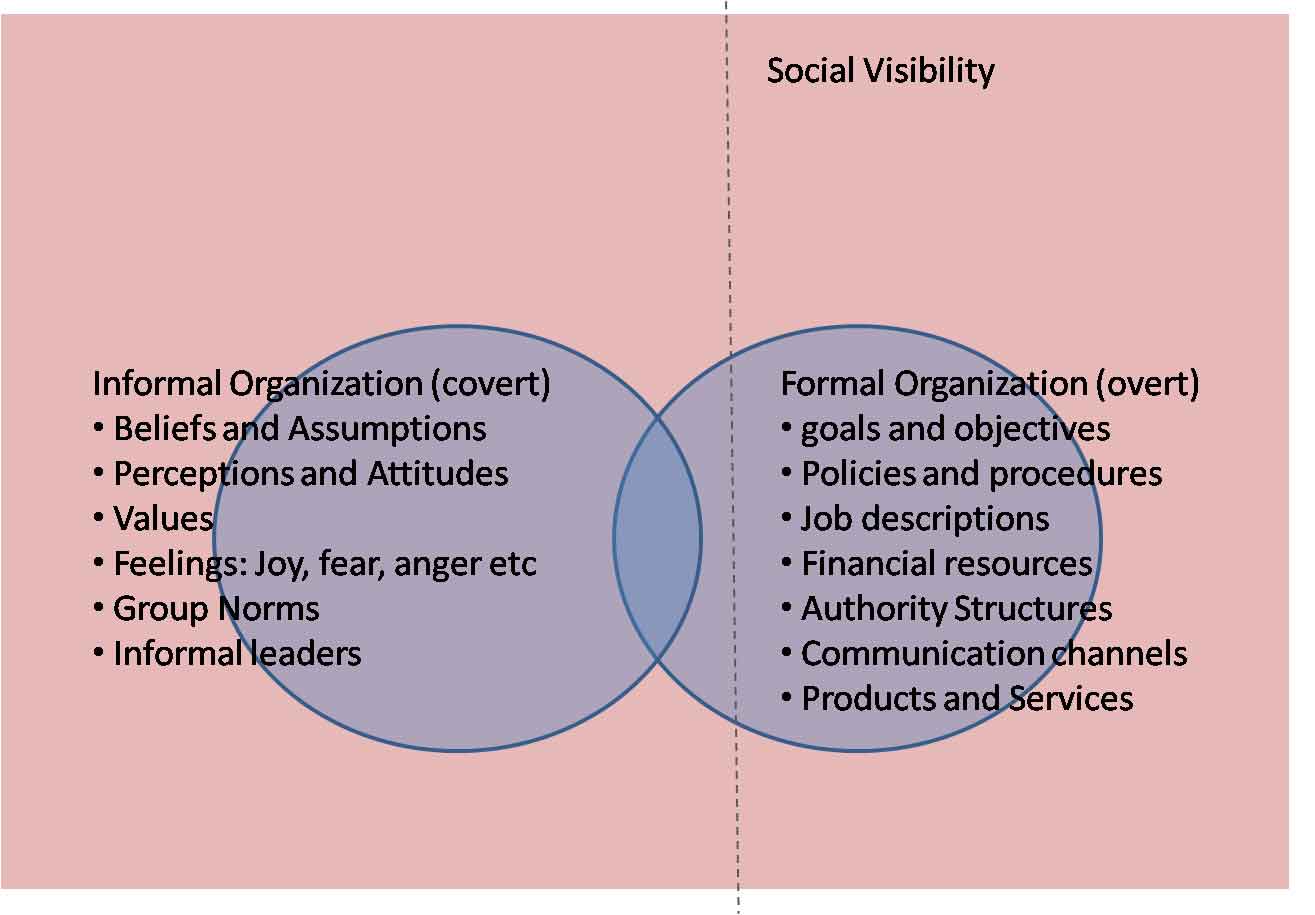
Formal and Informal Organization: Features, Advantages and Disadvantages
Formal Organisation:
When the managers are carrying on organising process then as a result of organising process an organisational structure is created to achieve systematic working and efficient utilization of resources. This type of structure is known as formal organisational structure.
Image Curtsey: 4.bp.blogspot.com/-0ZYemAhPloA/T47ig8Dbc4I/AAAAAAAAHoc/q1SBYoMF5Qo/s1600/Formal+and+informal+organizations.png
ADVERTISEMENTS:
Formal organisational structure clearly spells out the job to be performed by each individual, the authority, responsibility assigned to every individual, the superior- subordinate relationship and the designation of every individual in the organisation. This structure is created intentionally by the managers for achievement of organisational goal.
Features of Formal organisation:
(1) The formal organisational structure is created intentionally by the process of organising.
(2) The purpose of formal organisation structure is achievement of organisational goal.
ADVERTISEMENTS:
(3) In formal organisational structure each individual is assigned a specific job.
(4) In formal organisation every individual is assigned a fixed authority or decision-making power.
(5) Formal organisational structure results in creation of superior-subordinate relations.
(6) Formal organisational structure creates a scalar chain of communication in the organisation.
Advantages of Formal Organisation:
ADVERTISEMENTS:
1. Systematic Working:
Formal organisation structure results in systematic and smooth functioning of an organisation.
2. Achievement of Organisational Objectives:
Formal organisational structure is established to achieve organisational objectives.
ADVERTISEMENTS:
3. No Overlapping of Work:
In formal organisation structure work is systematically divided among various departments and employees. So there is no chance of duplication or overlapping of work.
4. Co-ordination:
Formal organisational structure results in coordinating the activities of various departments.
ADVERTISEMENTS:
5. Creation of Chain of Command:
Formal organisational structure clearly defines superior subordinate relationship, i.e., who reports to whom.
6. More Emphasis on Work:
Formal organisational structure lays more emphasis on work than interpersonal relations.
Disadvantages of Formal Organisation:
ADVERTISEMENTS:
1. Delay in Action:
While following scalar chain and chain of command actions get delayed in formal structure.
2. Ignores Social Needs of Employees:
Formal organisational structure does not give importance to psychological and social need of employees which may lead to demotivation of employees.
ADVERTISEMENTS:
3. Emphasis on Work Only:
Formal organisational structure gives importance to work only; it ignores human relations, creativity, talents, etc.
Informal Organisation:
In the formal organisational structure individuals are assigned various job positions. While working at those job positions, the individuals interact with each other and develop some social and friendly groups in the organisation. This network of social and friendly groups forms another structure in the organisation which is called informal organisational structure.
The informal organisational structure gets created automatically and the main purpose of such structure is getting psychological satisfaction. The existence of informal structure depends upon the formal structure because people working at different job positions interact with each other to form informal structure and the job positions are created in formal structure. So, if there is no formal structure, there will be no job position, there will be no people working at job positions and there will be no informal structure.
Features of informal organisation:
(1) Informal organisational structure gets created automatically without any intended efforts of managers.
(2) Informal organisational structure is formed by the employees to get psychological satisfaction.
ADVERTISEMENTS:
(3) Informal organisational structure does not follow any fixed path of flow of authority or communication.
(4) Source of information cannot be known under informal structure as any person can communicate with anyone in the organisation.
(5) The existence of informal organisational structure depends on the formal organisation structure.
Advantages of Informal Organisation:
1. Fast Communication:
Informal structure does not follow scalar chain so there can be faster spread of communication.
2. Fulfills Social Needs:
ADVERTISEMENTS:
Informal communication gives due importance to psychological and social need of employees which motivate the employees.
3. Correct Feedback:
Through informal structure the top level managers can know the real feedback of employees on various policies and plans.
Strategic Use of Informal Organisation. Informal organisation can be used to get benefits in the formal organisation in the following way:
1. The knowledge of informal group can be used to gather support of employees and improve their performance.
2. Through grapevine important information can be transmitted quickly.
ADVERTISEMENTS:
3. By cooperating with the informal groups the managers can skillfully take the advantage of both formal and informal organisations.
Disadvantages of Informal organisation:
1. Spread Rumours:
According to a survey 70% of information spread through informal organisational structure are rumors which may mislead the employees.
2. No Systematic Working:
Informal structure does not form a structure for smooth working of an organisation.
3. May Bring Negative Results:










